Desmodus Versio Manual#
Stereo-in, stereo-out synthetic tail-generator reverb and DSP platform
Overview#
Desmodus Versio is Noise Engineering's long anticipated take on a reverb. This is a true stereo in/stereo out or mono in/stereo out effect. Less of a room simulator and more of a synthetic tail generator with features designed for sound design and performance, the parameters on Desmodus Versio allow you to take the effect from a delay to a beautiful reverb to an uncanny, nightmarish atmosphere in the twist of a few knobs. Not only is Desmodus Versio a unique reverb, it's a stereo DSP platform. A simple USB connection allows you to update Desmodus Versio to a variety of firmwares. Open-source support is available, too, which allows you to write your own firmware! All info can be found on the World of Versio page here.
- Type: Stereo reverb/DSP platform
- Size: 10HP
- Depth: 1.5 Inches
Etymology#
Desmodus -- from Latin: "vampire bat"
Versio -- from Latin: "versatile"
"Versatile Vampire"
Color code#
On boot, the Versio's LEDs will shine with this color pattern to indicate that it is running the current Desmodus Versio firmware:
Power#

To power your Versio, turn off your case. Plug one end of your ribbon cable into your power board so that the red stripe on the ribbon cable is aligned to the side that says -12 V and each pin on the power header is plugged into the connector on the ribbon. Make sure no pins are overhanging the connector! If they are, unplug it and realign.
Line up the red stripe on the ribbon cable so that it matches the white stripe and/or -12 V indication on the board and plug in the connector.
Screw your module into your case before powering on the module. You risk bumping the module's PCB against something metallic and damaging it if it's not properly secured when powered on.
If your Versio looks like the left picture, it requires 70mA +12v and 70mA -12v. If it looks
like the right picture, it requires 125mA +12v and 10mA -12v. Versio does not use the
+5v rail.
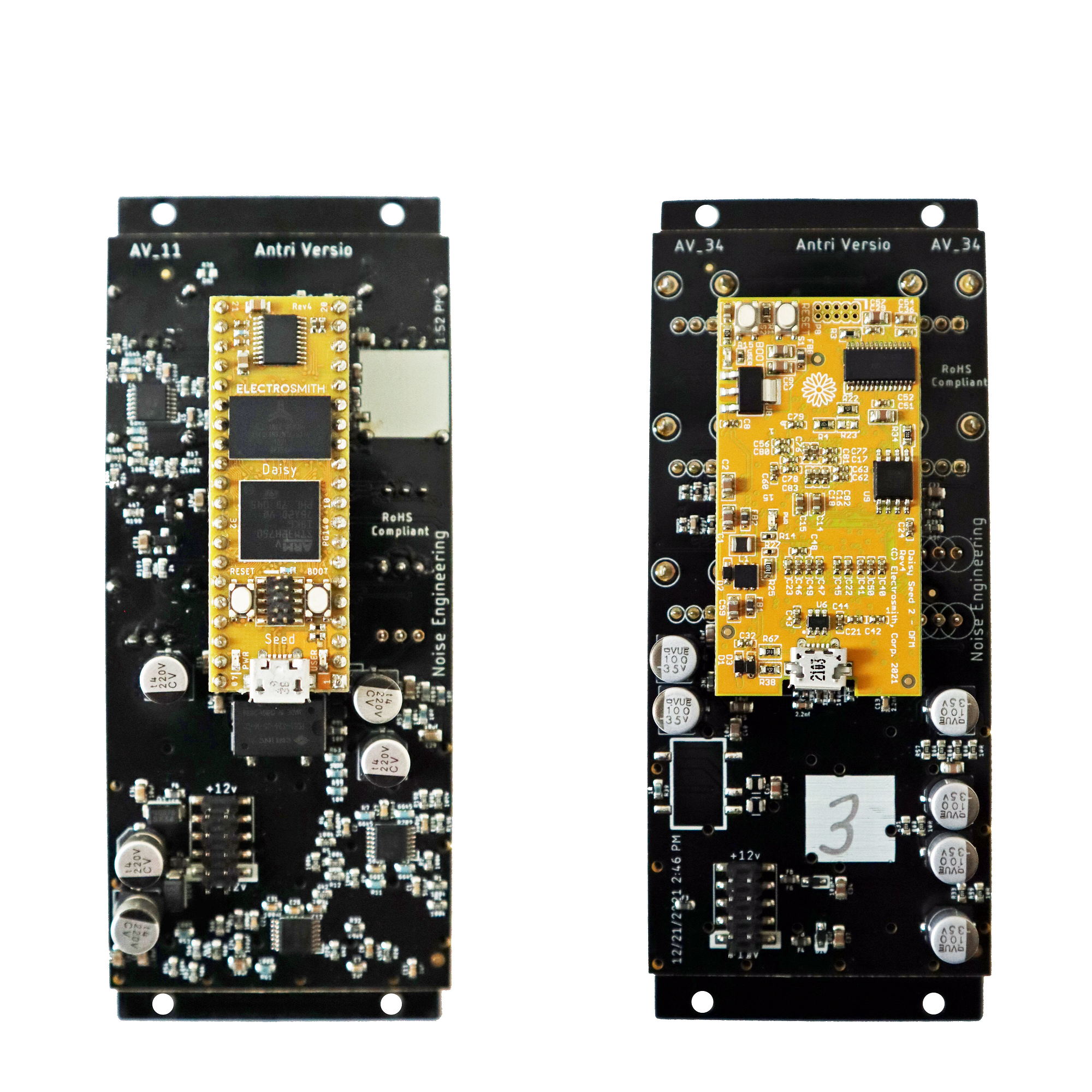
You should be good to go if you followed these instructions. Now go make some noise!
Input & output voltages#
All CV inputs expect 0 V to 5 V. All pots act as offsets and sum with the input CV. The gate input responds to signals above +2 V. The audio inputs clip around 16 V peak to peak.
Interface#
- Blend
-
Dry/wet balance control. When turned fully left, the unmodified input signal is passed through. Fully right, only the processed signal is heard. Points in the middle give you a mix of both.
A good way to hear Blend is with high Regen values and Tone and Index set to 12 o'clock.
- Tone
-
A filter in the reverb tank. This is a bipolar control: turning the knob to the left controls a lowpass filter, and to the right controls a highpass filter. In the center, the filter is disabled.
A good way to hear Tone is with high Regen values, and Blend and Index at 12 o'clock.
- Regen
-
Amount of feedback in the reverb tank. Regen controls a wide range of tones and behaviors.
All the way to the left, feedback is minimized. As you turn up to about 12 o'clock, Desmodus Versio generates shorter reverbs, emulating smaller synthetic spaces. Past this point, the reverb reaches 100% feedback, creating spaces with an infinite tail. Past 3 o'clock, the infinite reverbs are ducked by new sounds at the input, creating sidechain-type effects.
- Speed
-
The speed of the internal LFO. The LFO can modulate the delay lines, and modulation amount is controlled by the Index parameter.
A good way to hear Speed is with a low Size setting, Density and Index fully clockwise, and a high Regen setting.
- Index
-
The amount of LFO sent to the delay lines that make up the reverb. This is a bipolar control: in the center the LFO is disabled. To the left, the LFO modulates the delay lines randomly. To the right, the LFO modulates the delay lines with a sine wave. The Speed parameter controls the rate of the LFO.
A good way to hear Index is with a low Size setting, Density fully clockwise, Speed at 12 o'clock, and a high Regen setting.
- Size
-
The delay time of the reverb.
A good way to hear Size is with a percussive input and all other parameters at 12 o’clock.
- Dense
-
The spacing of the delay lines. To the left, the effect sounds more like a delay; to the right, the delays are smeared into reverb.
A good way to hear Dense is with a percussive input, Size fully clockwise, and all other parameters at 12 o'clock.
- FSU
-
This control maxes out the Regen control and mutes the input to the reverb when the button is pressed, or when a high gate is sent to its input.
A good way to hear this button's effect is with Blend above 12 o'clock and a low Regen value.
- In L/In R
- Audio input. If R is not patched, the signal from L is normaled to both inputs.
- Out L/Out R
- Stereo output pair.
- LIM/DST/SHM
- Reverb style.
- LIM (Limit): A clean reverb, using limiting within the reverb tank to contain feedback. A good way to hear LIM is with moderate Regen values and starting with all other parameters at 12 o'clock, then playing with Tone and Index/Speed.
- DST (Distort): Similar to LIM, but instead of limiting within the reverb tank, slight saturation is applied for a more distorted sound. A good way to hear DST is with high Regen values and starting with all other parameters at 12 o'clock, then adjusting Size and Tone to taste.
- SHM (Shimmer): A demonic pitch-shifting algorithm. Adds a one octave pitch shift that feeds back into the input. A good way to hear SHM is with high Regen values, and all other parameters at 12 o'clock. Create haunting effects by introducing subtle modulation with Speed and Index.
- BND/LRP/JMP
- Changes how the delay lines respond when the panel controls are modulated. To hear each mode clearly, turn Regen fully clockwise and modulate the Size parameter.
- BND (Blend): Crossfades the delay times for smoother changes.
- LRP (Interpolate): Slowly changes delay line length, has audible pitch shift effects due to the delay lines changing length.
- JMP (Jump): Quickly changes delay line length, for audible and fast changes.
Patch tutorial#
- Basic Lush
- Patch a sound source to In L (and In R if sound is stereo). Patch Out L and Out R to your mixer. Set knobs as shown, and flip the switches to LIM and BND. Experiment with different Regen values under 12 o’clock for different reverb lengths, and above 12 o’clock for different infinite reverb tones. Return Regen to the 11 o’clock position and hold FSU to unleash some chaos.
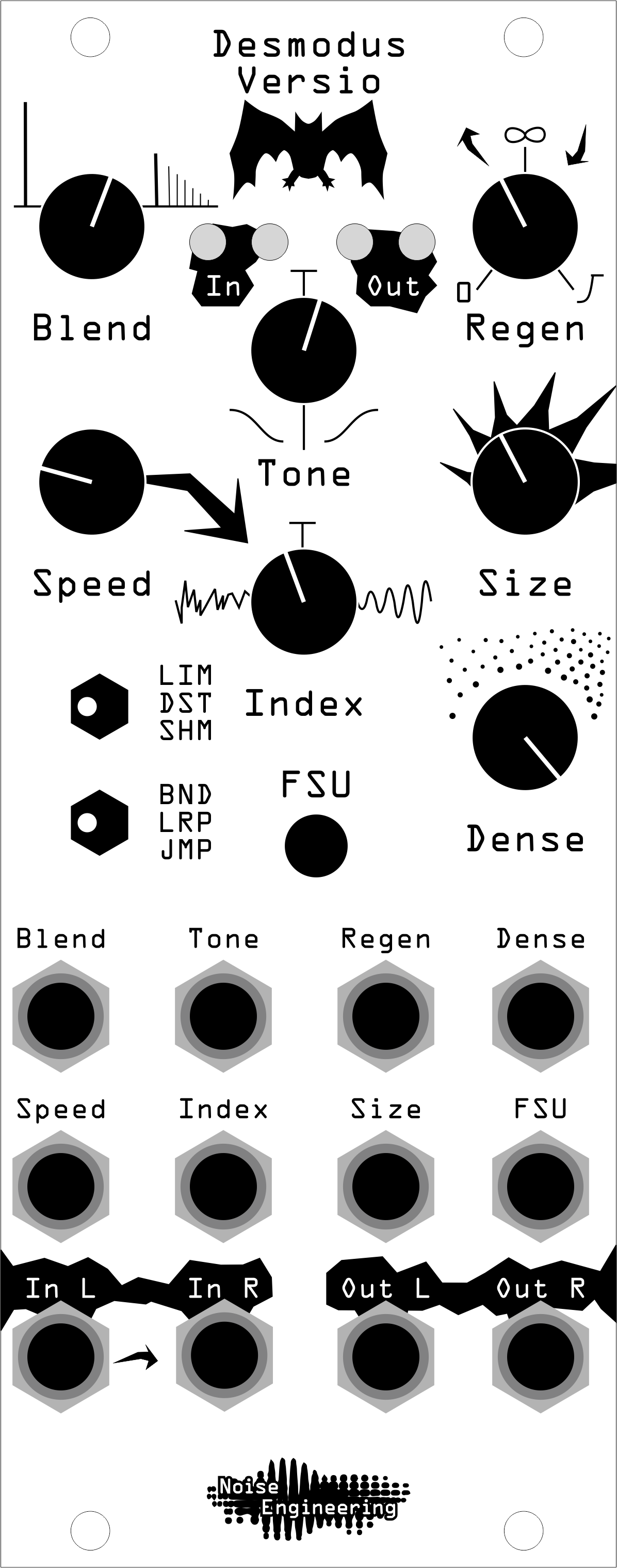
- Basic Shimmer
- Patch a sound source to In L (and In R if sound is stereo). Patch Out L and Out R to your mixer. Set knobs as shown, and flip the switches to SHM and BND. This patch creates a pitch-shifting shimmer in a gentle infinite space.

- Delay
- Patch a sound source to In L (and In R if sound is stereo). Patch Out L and Out R to your mixer. Set knobs as shown, and flip the switches to LIM and BND. Play with the Size parameter to change the delay times, and the Tone parameter to change the flavor of the delay. Note that higher Size and lower Dense values are needed for clear delays.
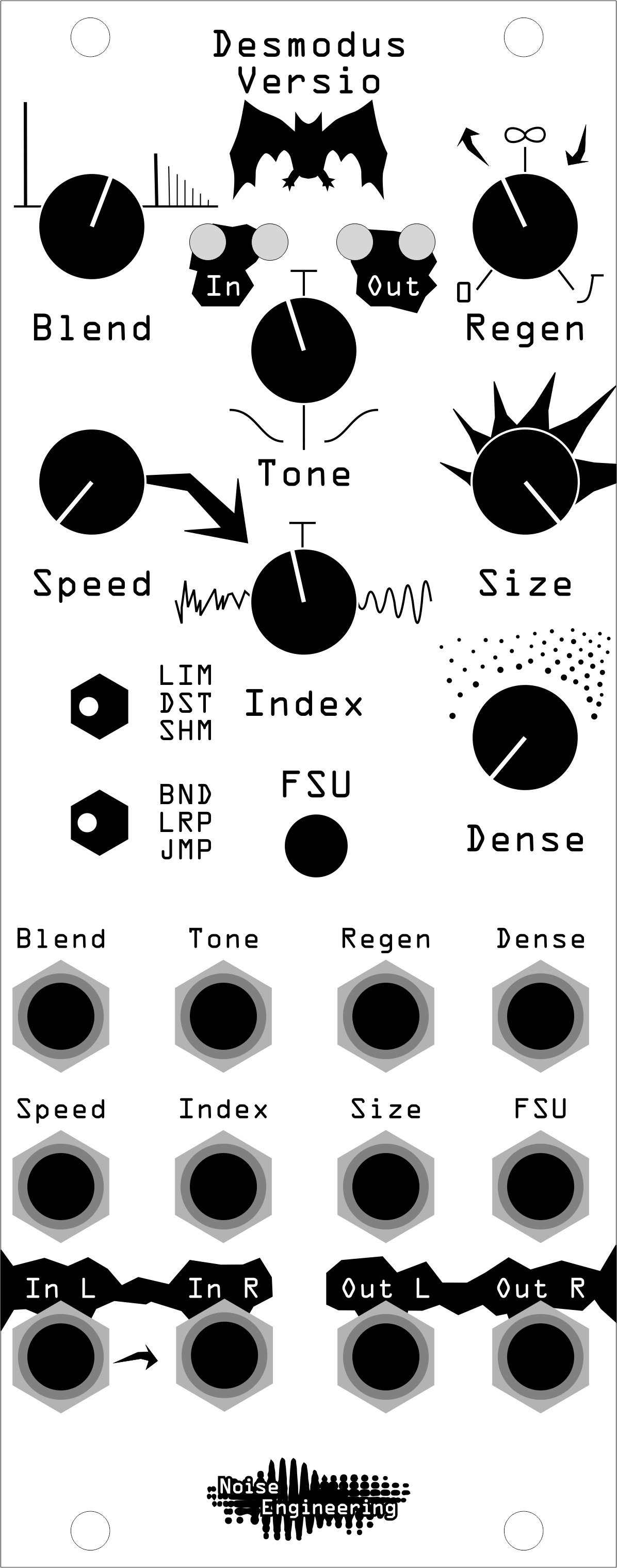
- Kick Ducker
- For this sound, use a percussive sound like a kick drum. Patch it to In L. Patch Out L and Out R to your mixer. Set knobs as shown, and flip the switches to DST and BND. Each time your kick is triggered, the reverb will duck, creating a sidechain effect.
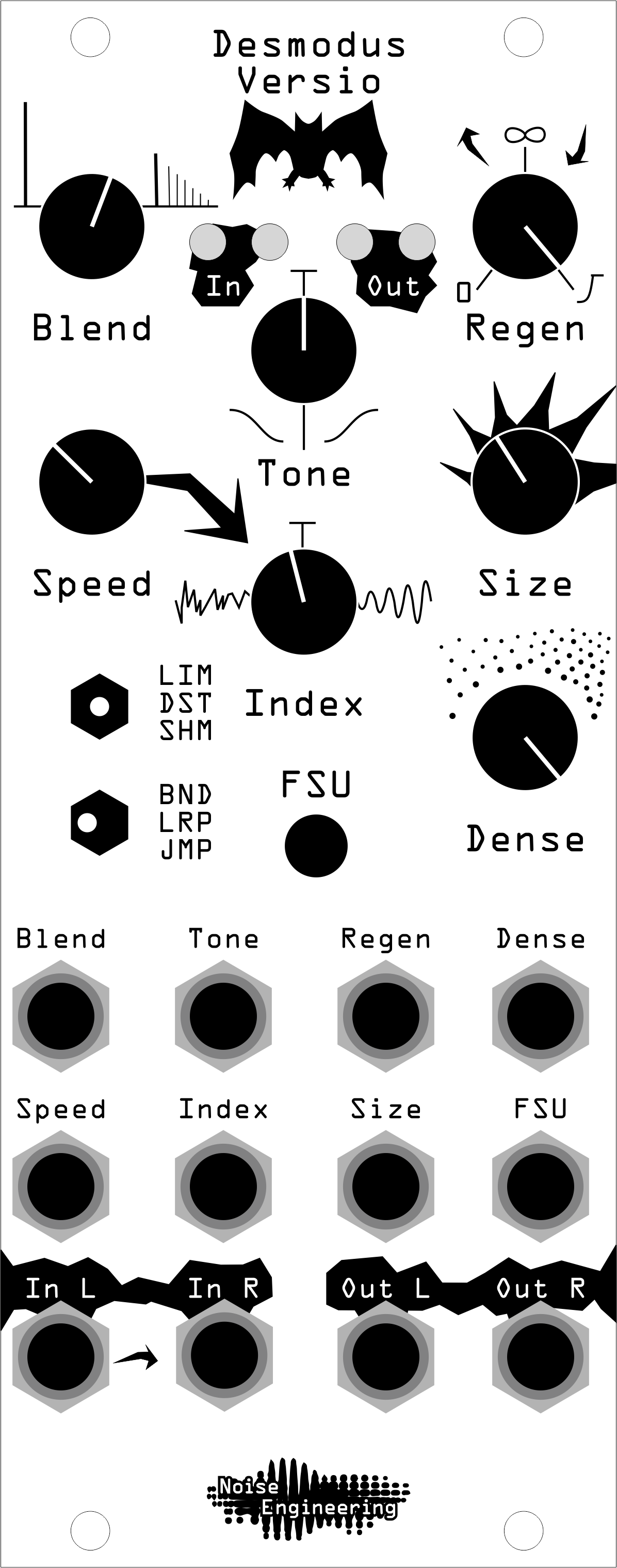
- Voice
- No input needed; patch Out L and R to your mixer. Set knobs as shown, and flip the switches to DST and BND. Patch a gate sequence to FSU (marked pink), or manually press the FSU button. Each time FSU is activated, DV “pings” a short burst of noise into the reverb tank, causing the reverb to self-oscillate. It will then stop oscillating when the gate goes low again. Modulate Size (marked green) to change the frequency of the oscillation and create different flavors of noise. Increasing the Regen value to anything below 12 o’clock will increase the “release” time when the gate goes low.

- Chaotic Verb
- Patch a sound source to In L (and In R if sound is stereo). Patch Out L and Out R to your mixer. Set knobs as shown, and flip the switches to DST and JMP. This patch uses high-freqency delay line modulation and the DST algorithm to create a chaotic atmosphere. Try different Index, Speed, and Tone settings to create different flavors of chaos.
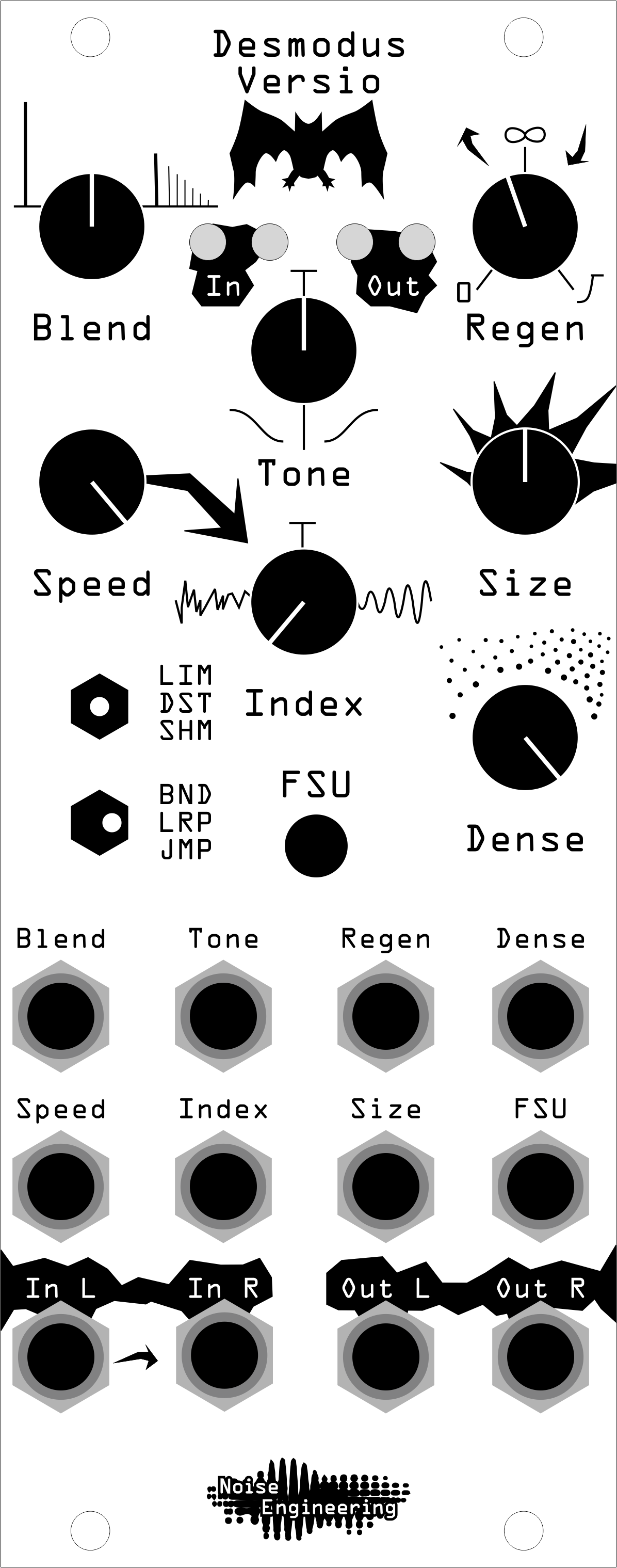
- Metal Crash
- No input needed; patch Out L and R to your mixer. Set knobs as shown, and flip the switches to DST and JMP. Send modulation (an envelope, random CV source or stepped CV sequence will do) to Size (marked pink). This patch uses DV as an oscillator and creates metallic crashing based on the modulation of the Size parameter. Experiment with different types of modulation to create different metallic sounds.
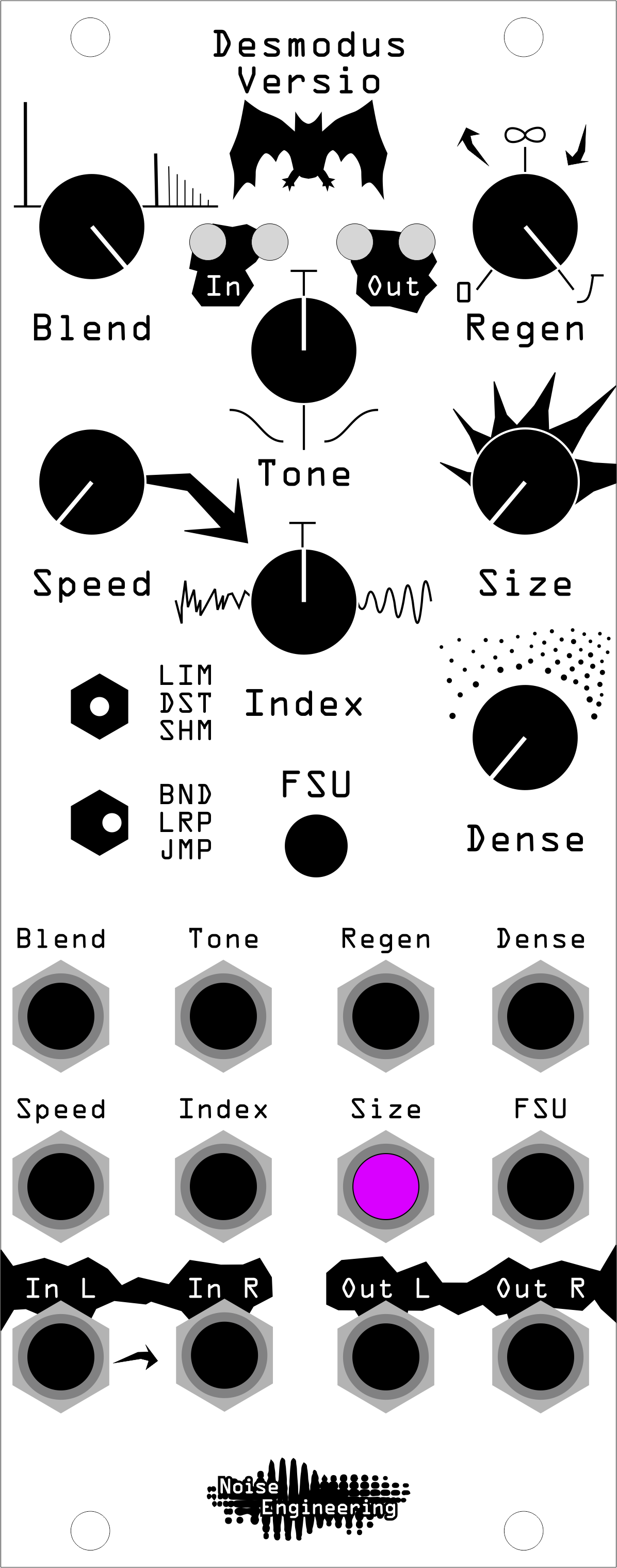
- 1.5v
- Patch a sound source to In L (and In R if sound is stereo). Patch Out L and Out R to your mixer. Set knobs as shown, and flip the switches to DST and JMP. Send a 1.5v-1.6v signal to FSU (marked pink). This gets close to the gate threshold but doesn’t quiet pass it, causing FSU to do some interesting things. Try suddenly increasing that voltage for a unique tail.
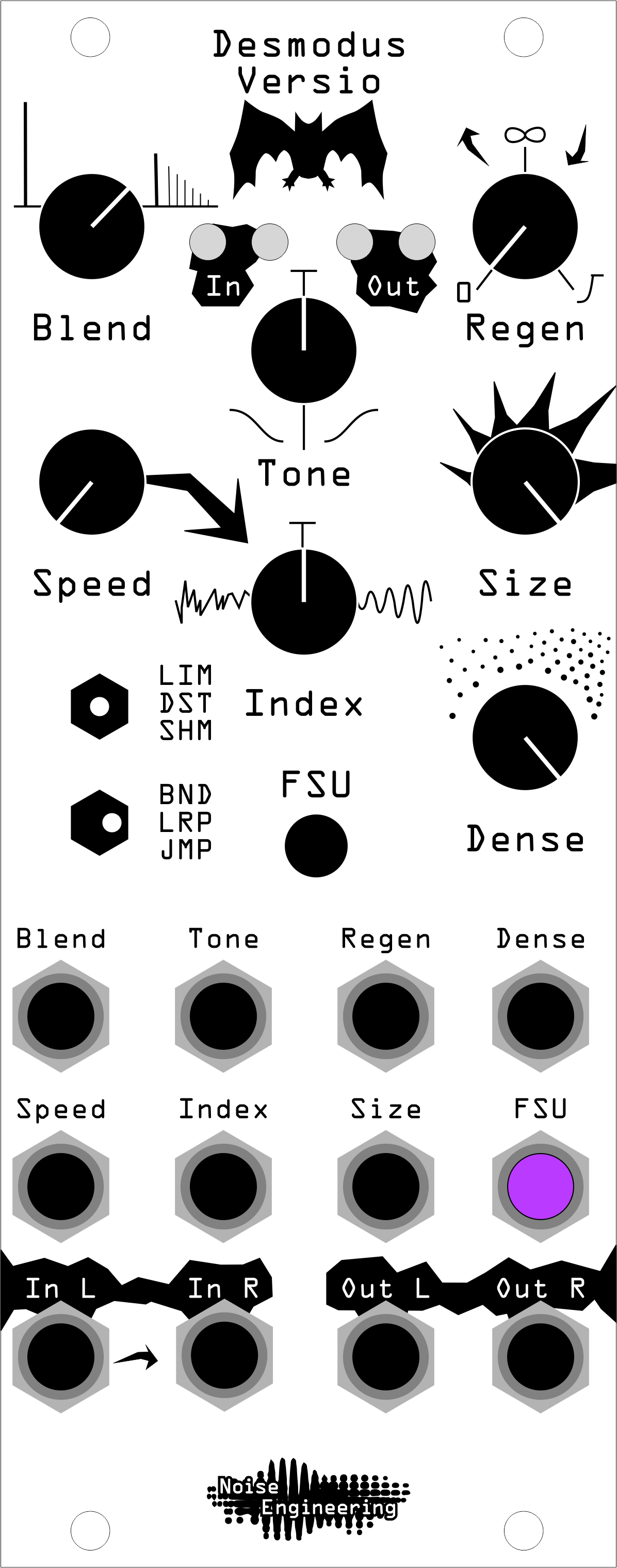
- Motorcycle
- Patch a kick to In L. Patch Out L and Out R to your mixer. Set knobs as shown, and flip the switches to DST and BND. This patch utilizes the unique properties of the DST algorithm to create some very unique and choppy artifacts.

- Helicopter
- Patch a sound source to In L (and In R if sound is stereo). Patch Out L and Out R to your mixer. Set knobs as shown, and flip the switches to DST and BND. Just like the last patch, this example uses DST to create some interesting distorted artifacts and dynamics. Experiment with different Size settings to change up your sound.
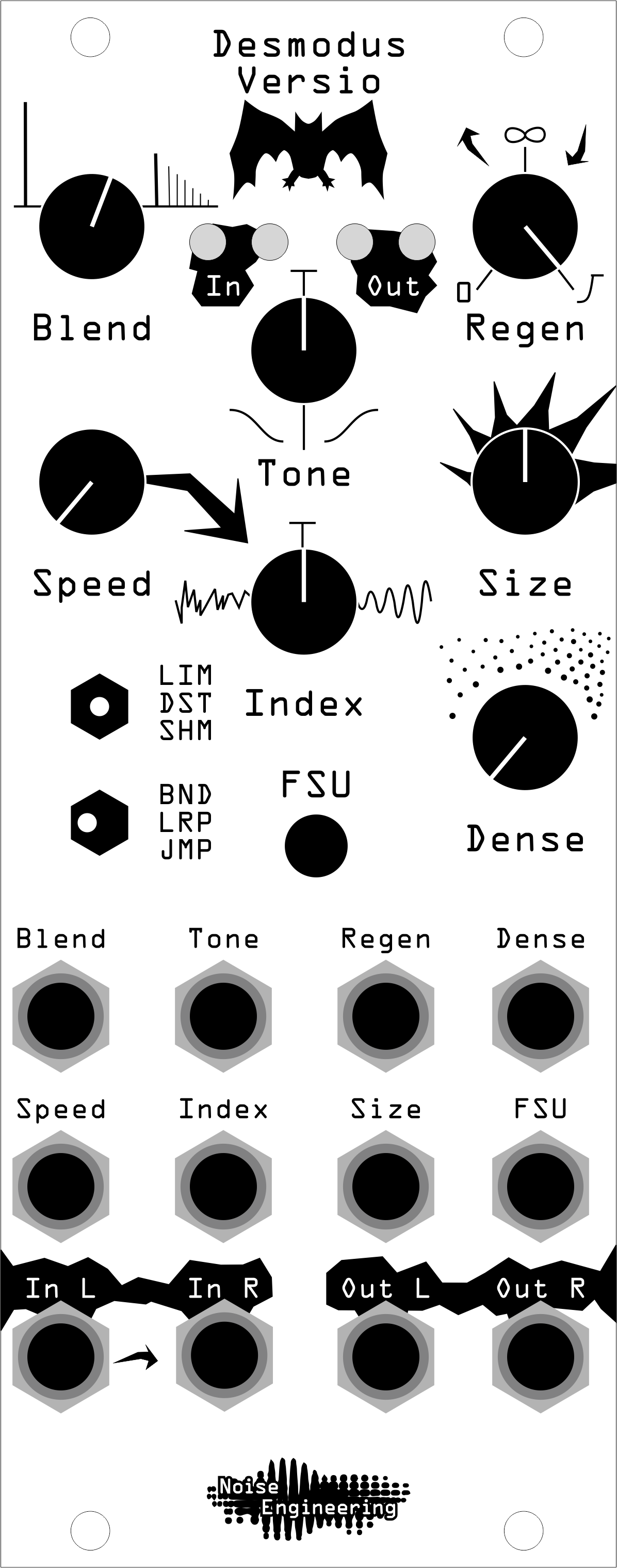
Firmware swapping#
Use our firmware swap app to change your platform module's firmware at any time.
To get started:
- Turn off the power to your case and unscrew the module.
- Remove the power connector on the back of the module.
- Plug a micro USB connector into the port on the pack of the module, and the other end into your computer.
- Follow the instructions in the firmware swap app.
Desmodus conservation#
We've known for a long time that we wanted to do a reverb, and it seemed like a pretty obvious opportunity for us to revisit our core values and support another conservation charity. With a reverb module, bats seemed like a pretty obvious connection: many bat species use echolocation, where they send out an ultrasonic signal, and then listen for subtle shifts in the returned echo. Those shifts can tell them incredible details about their environment, including the location of prey -- even while they are both moving! Bats are the most species-diverse group of mammals, and critically important to ecosystems. Insect-eating bats eat literally tons of insects annually, including those that damage crops. One estimate says bats are worth more than $3.7 billion USD / year in reduced crop damage and pesticide use! They also pollinate a variety of crops and disperse seeds for a lot of plants, including plants that we humans are fond of. In addition, bats are in trouble. Habitat loss and other human-made causes are among the biggest threats. And in North America, a new fungal pathogen called White-nose Syndrome is killing bat colonies as they hibernate (in some places, leading to complete devastation of colonies).
We've partnered with Bat Conservation International (www.batcon.org), the global leader in bat conservation. We've committed to donate a portion of the proceeds from every DV sold to bat conservation. That means you can pat yourself on the back for buying a Desmodus Versio, knowing you're doing some good in the world! Want to know more about bats? Learn how to build a bat house? Find out what you can do? Check out the BCI website.
Design notes#
We have wanted to make a reverb for a long, long time. Our biggest block was always having a suitable computational platform. The platform we use for our oscillators is phenomenal for oscillators but does not have enough storage for most audio effects.
In mid-2019, Electrosmith sent us a platform that they were developing for the DIY market to test and give feedback on. This platform would become the core to the Daisy line that they now sell. The first nontrivial test we did with Daisy was to port some of the reverb work that Stephen had been developing on and off for years. Stephen performed at MOTS LA in the summer of 2019 with the Daisy prototype running this reverb literally taped to the side of his case.
At that time, we were in the midst of designing our own platform similar to Daisy (code named George) though after one iteration we decided that where Electrosmith had decided to go with the Daisy Seed was going to be a suitable platform for us so adopted the Seed for our hardware backend. The stars aligned and we were pretty confident we were close to release by the end of that year.
We announced Desmodus Versio at NAMM 2020. A few weeks later, we got the first inkling that something was amiss when the factories in China (where we get PCBs and parts) didn't really return from the Lunar New Year holiday. It seems like no time after that when the COVID-19 pandemic became official and 2020 became a year entirely out of our control. Releasing a new module no matter how much anticipated became untenable for nearly six months (but we appreciate all the emails desperate for the module!). Supply chains broke down, California (and almost everywhere else) shut down, our manufacturing came to a virtual halt, and our employees were sent to work from home sans new hardware to test, since we didn't yet have it. It took several months (and another unexpected iteration or two) before we got to a point where we could actually put Desmodus into production.
Oh and yes... Stephen grew as much of a beard as he is capable of for the development of this product.
Warranty#
We will repair or replace (at our discretion) any product that we manufactured as long as we are in business and are able to get the parts to do so. We aim to support modules that have been discontinued for as long as possible. This warranty does not apply to normal wear and tear, including art/panel wear, or any products that have been modified, abused, or misused. Our warranty is limited to manufacturing defects.
Warranty repairs/replacements are free. Repairs due to user modification or other damage are charged at an affordable rate. Customers are responsible for the cost of shipping to Noise Engineering for repair.
All returns must be coordinated through Noise Engineering; returns without a Return Authorization will be refused and returned to sender.
Please contact us if you think one of your modules needs a repair.
Special thanks#
- Stephen Hensley
- ElectroSmith
- Cynthia Hitchcock
- Bat Conservation International
- All the people who emailed to tell us how excited and interested they were, despite the wait!